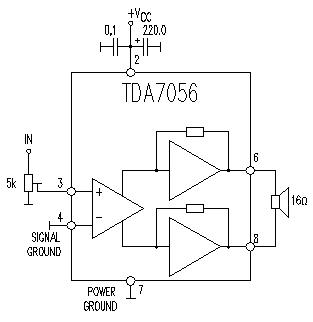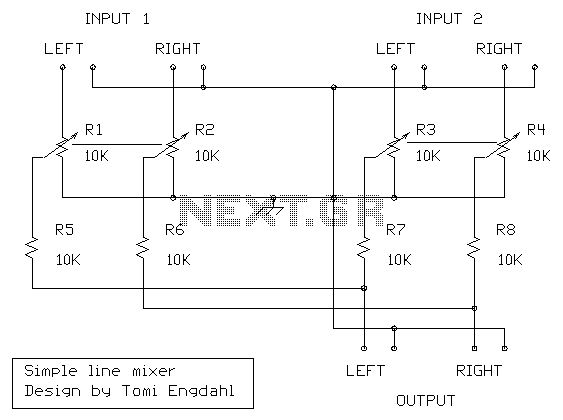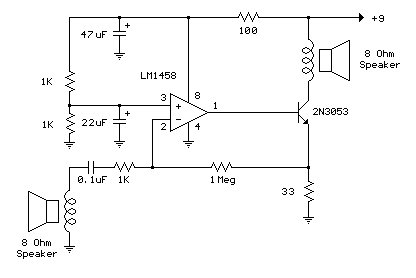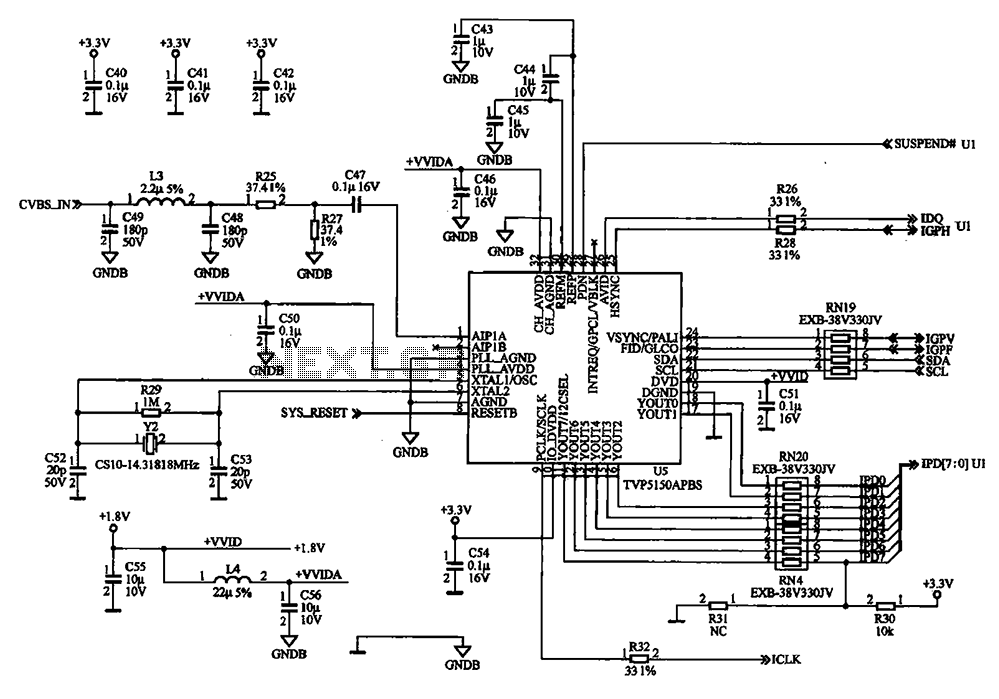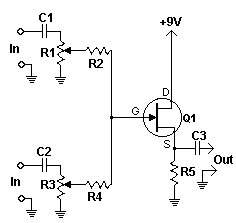
Audio booster
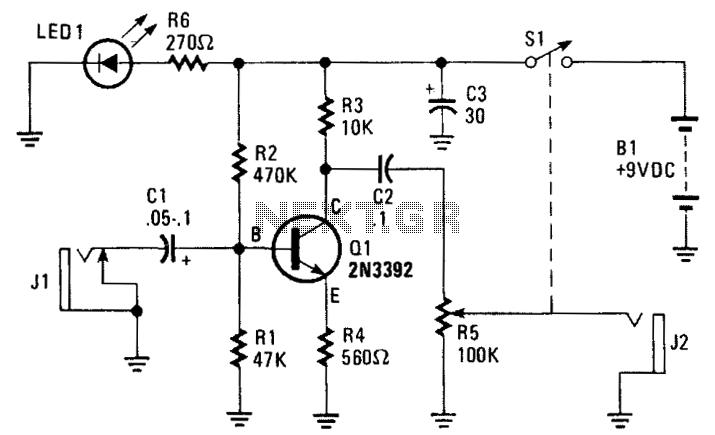
The amplifier's gain is nominally 20 dB. Its frequency response is determined primarily by the values of a few components, mainly C1 and R1. The schematic diagram values provide a response of ±3.0 dB from approximately 120 Hz to over 20,000 Hz. In fact, the frequency response is relatively flat from about 170 Hz to well above 20,000 Hz; the deviation from a flat frequency response occurs at the low end. The low-end roll-off is mainly influenced by capacitor C1, as the resistive value of R1 is fixed. If the value of C1 is changed to 0.1 pF, the low-end corner frequency—the frequency at which the low-end roll-off begins—is reduced to about 70 Hz. For an even deeper low-end roll-off, changing C1 to a 1.0 µF capacitor is suggested; if using an electrolytic type, it is essential to ensure correct polarity, with the positive terminal connected to the base terminal of Q1.
The amplifier circuit under discussion is designed to achieve a nominal gain of 20 dB, which is a standard level for audio amplification. The frequency response is critically influenced by the values of the components C1 and R1, which are integral to establishing the operational bandwidth of the amplifier. The specified frequency response of ±3.0 dB indicates that the amplifier will maintain its performance within this range, effectively covering audio frequencies from around 120 Hz to 20 kHz.
The flat frequency response from about 170 Hz to over 20 kHz suggests that the amplifier is well-suited for applications requiring high fidelity, such as in audio processing or musical instrument amplification. However, attention must be paid to the low-end response, as it begins to roll off below 170 Hz. This roll-off is primarily dictated by the capacitance of C1, as R1 remains constant, thus establishing a predictable low-frequency behavior.
In scenarios where further low-end extension is desired, adjusting the capacitance of C1 can significantly impact the performance. For instance, reducing C1 to 0.1 pF lowers the corner frequency to approximately 70 Hz, enhancing the amplifier's ability to reproduce lower frequencies. Additionally, if a more substantial low-end roll-off is necessary, substituting C1 with a 1.0 µF electrolytic capacitor is recommended. It is crucial to install this capacitor with the correct polarity to prevent damage and ensure proper circuit functionality; the positive terminal must connect to the base terminal of Q1, which is likely a transistor pivotal for the amplifier's operation.
This circuit's design considerations highlight the importance of component selection and configuration in achieving desired audio characteristics, making it essential for engineers to understand the implications of each component's value on the overall performance of the amplifier.The amplifier's gain is nominally 20 dB. Its frequency response is determined primarily by the value of just a few components—primarily Cl and Rl. The values of the schematic diagram provide a response of ±3.0 dB from about 120 Hz to better than 20,000 Hz.
Actually, the frequency response is ruler flat from about 170 Hz to well over 20,000 Hz; it's the low end that deviates from a flat frequency response. The low end's roll-off is primarily a function of capacitor Cl (since Rl's resistive value is fixed).
If Cl's value is changed to 0.1 pF, the low end's corner frequency—the frequency at which the low-end roll-off starts—is reduced to about 70 Hz. If you need an even deeper low-end roll-off, change Cl to a 1.0 µ¥ capacitor; if it's an electrolytic type, make certain that it's installed into the circuit with the correct polarity, with the positive terminal connected to Ql's base terminal.
The amplifier circuit under discussion is designed to achieve a nominal gain of 20 dB, which is a standard level for audio amplification. The frequency response is critically influenced by the values of the components C1 and R1, which are integral to establishing the operational bandwidth of the amplifier. The specified frequency response of ±3.0 dB indicates that the amplifier will maintain its performance within this range, effectively covering audio frequencies from around 120 Hz to 20 kHz.
The flat frequency response from about 170 Hz to over 20 kHz suggests that the amplifier is well-suited for applications requiring high fidelity, such as in audio processing or musical instrument amplification. However, attention must be paid to the low-end response, as it begins to roll off below 170 Hz. This roll-off is primarily dictated by the capacitance of C1, as R1 remains constant, thus establishing a predictable low-frequency behavior.
In scenarios where further low-end extension is desired, adjusting the capacitance of C1 can significantly impact the performance. For instance, reducing C1 to 0.1 pF lowers the corner frequency to approximately 70 Hz, enhancing the amplifier's ability to reproduce lower frequencies. Additionally, if a more substantial low-end roll-off is necessary, substituting C1 with a 1.0 µF electrolytic capacitor is recommended. It is crucial to install this capacitor with the correct polarity to prevent damage and ensure proper circuit functionality; the positive terminal must connect to the base terminal of Q1, which is likely a transistor pivotal for the amplifier's operation.
This circuit's design considerations highlight the importance of component selection and configuration in achieving desired audio characteristics, making it essential for engineers to understand the implications of each component's value on the overall performance of the amplifier.The amplifier's gain is nominally 20 dB. Its frequency response is determined primarily by the value of just a few components—primarily Cl and Rl. The values of the schematic diagram provide a response of ±3.0 dB from about 120 Hz to better than 20,000 Hz.
Actually, the frequency response is ruler flat from about 170 Hz to well over 20,000 Hz; it's the low end that deviates from a flat frequency response. The low end's roll-off is primarily a function of capacitor Cl (since Rl's resistive value is fixed).
If Cl's value is changed to 0.1 pF, the low end's corner frequency—the frequency at which the low-end roll-off starts—is reduced to about 70 Hz. If you need an even deeper low-end roll-off, change Cl to a 1.0 µ¥ capacitor; if it's an electrolytic type, make certain that it's installed into the circuit with the correct polarity, with the positive terminal connected to Ql's base terminal.
